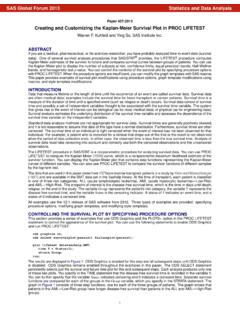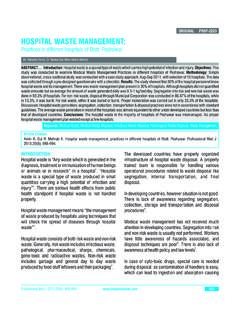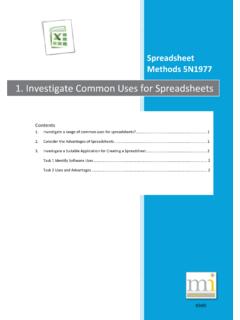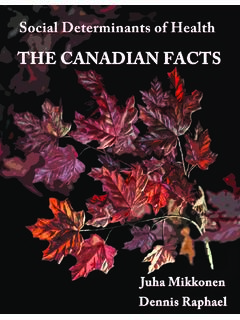Transcription of STARTING A NARRATIVE SYNTHESIS - Cochrane
1 How to cite this document: Ryan R; Cochrane Consumers and Communication Review Group. Cochrane Consumers and Communication Review Group: data SYNTHESIS and analysis . , June 2013 (accessed DATE). 1 DATA SYNTHESIS AND ANALYSIS Consumers and Communication Review Group (CC&CRG) reviews often assess complex interventions. Commonly, these reviews: cannot analyse data using meta analysis; can only pool some of the included studies and/or data statistically; include data from different study designs that are not suitable for lumping all together in analysis; or may have captured a very wide range of interventions.
2 Therefore, other ways of expressing and synthesising the results of studies collected together for review are needed. We often describe these methods as NARRATIVE analysis or SYNTHESIS . Additionally, even where meta analysis is used, the results need to be described and integrated in the text of the review. A NARRATIVE SYNTHESIS can provide a first step in looking systematically at, and organising, the data. Since NARRATIVE SYNTHESIS will be used to a greater or lesser extent in a review, the methods for performing the SYNTHESIS need to be described at protocol stage.
3 Pre specifying the approach to SYNTHESIS may also help to avoid emphasising some findings above others, even inadvertently, and so may reduce the potential for unsubstantiated claims to appear in the SYNTHESIS . At review stage, authors will make further decisions about how best to organise and present the data based on the actual review findings. While it may be possible or necessary to make some changes to the SYNTHESIS approach after the protocol has been developed, thinking through and planning the approach at protocol stage is still very important, and changes made at later stages of the review may need to be justified in terms of a rationale for making changes.
4 This document aims to assist authors in planning their NARRATIVE analysis at protocol stage, and to highlight some issues for authors to consider at review stage. NARRATIVE forms of SYNTHESIS are an area of emerging research, and so advice is likely to be adapted as methods develop. This document sits alongside the RevMan templates for protocols and reviews developed by the CC&CRG, as the examples of different approaches to analysis and SYNTHESIS in CC&CRG reviews, all available at resources STARTING A NARRATIVE SYNTHESIS Synthesising narratively the results of different studies in a review is not simply describing or summarising the main features of each in turn, although doing this can be a STARTING point.
5 For example, describing the included studies, and describing and commenting on the methodological quality (risk of bias) of each study can be used for authors to become familiar with the data, as a first step in the SYNTHESIS process. An initial stage in any SYNTHESIS is to become familiar with the results of the included studies. This means assessing systematically and comprehensively the results of each study, highlighting important characteristics of the studies 2 where relevant, such as important similarities or differences (for example, in study design, populations, interventions or other elements).
6 SUMMARISE AND SYNTHESISE DIFFERENT STUDY DESIGNS SEPARATELY In those CC&CRG reviews which include studies of diverse designs, we suggest that these designs be dealt with separately in summaries and syntheses. This is because different study designs have fundamentally different methodological strengths and weaknesses, and should not be treated as though they are equivalent. For example, if a review has included randomised controlled trials (RCTs) plus non randomised studies, the SYNTHESIS of studies could be divided into RCTs, quasi RCTs and so on. Authors should also: explore any potential heterogeneity in the results that might be due to differences in study designs (eg.)
7 RCTs and non RCTs coming to different conclusions about the particular effects of an intervention); compare the results of RCTs with those of quasi RCTs; and highlight any similarities or differences in the findings within the review. OVERVIEW OF DIFFERENT APPROACHES TO SYNTHESIS There are different ways to approach NARRATIVE data SYNTHESIS . The approach you choose will be determined by the type of question your review is attempting to address. It will also be affected by the characteristics of the included studies. The key to any rigorous SYNTHESIS of data, whether NARRATIVE or statistical, should be that the processes employed avoid bias.
8 The process of NARRATIVE data SYNTHESIS must therefore itself be rigorous and transparent, ideally with methods specified in advance (ie. at protocol stage) although this may not always be possible. These methods should be justified and followed systematically. A NARRATIVE SYNTHESIS can be challenging, especially if: the review includes a large number of studies; the studies examine complex interventions and outcomes; or there is a lot of variation in the effects of the intervention. Patterns of effects, and similarities or differences between studies may not be immediately obvious, and so adopting a systematic approach to SYNTHESIS is key to making sense of the results.
9 We encourage authors to attempt a NARRATIVE SYNTHESIS that includes investigation of the similarities and the differences between the findings of different studies, as well as exploration of patterns in the This might involve examining associations between study outcomes and any other factors related to the study design and conduct. For example, considering the results of studies of different design (eg. RCTs and non RCTs), or with different forms of intervention implementation or delivery, could be ways to approach the SYNTHESIS . Reasons for both similarities and differences in the findings should also be explored systematically, with possible explanations for the pattern of results considered in a logical way for each of the included studies.
10 See the Examples of NARRATIVE SYNTHESIS guide at resources 1 This compares with the approaches taken by meta analysis, in which heterogeneity in study results is examined statistically. 3 NARRATIVE SYNTHESIS GUIDELINES Guidelines are available to help review authors to structure NARRATIVE syntheses of results in systematic These outline several steps that can help review authors to systematically analyse and then integrate the results across studies, and so form conclusions based on the assembled body of evidence.







